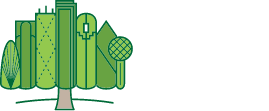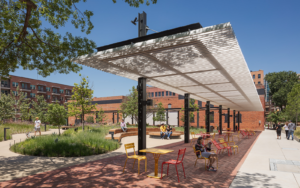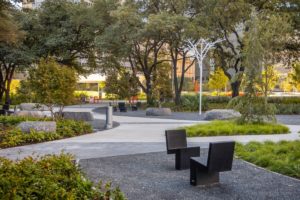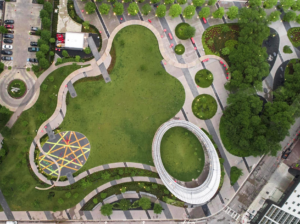Chuck McDaniel is the managing principal architect for SWA. He is a graduate of Texas A&M University, and his resume includes design work on Atlanta’s award-winning Georgia International Plaza, as well as the popular Las Ventanas al Paraiso resort in Cabo San Lucas, Mexico. Chuck is also one of the driving forces behind Pacific Plaza, one of four new proposed parks poised to transform downtown Dallas. In choosing to work with city leaders and the public on this project, Chuck and SWA have taken on a whole new set of challenges. As Chuck discusses below, the aesthetic and environmental benefits of Pacific Plaza are significant, but the path to realizing those benefits entails a good bit of hard work, and not all of it confined to drawing up blueprints.
What is the history of Pacific Plaza and what makes it unique?
The earliest record we found is from 1892. During that early period, the site was lightly developed, and the businesses that existed on the site were most likely there to service the Texas and Pacific Railroad. By 1921, the site was largely vacant. It’s surprising that as Dallas developed, this site did not evolve into another use, like a high-rise office building.
A unique feature of the site is the large grove of live oak and honey locust trees in the southeast corner. The trees are a part of the existing Aston Park, which was dedicated in 1983. The honey locust trees have declined as a result of being shaded out by the live oaks. The live oaks are mature and healthy, and their collective canopies provide a wonderful shaded area right in downtown. Our plan incorporates the majority of the live oaks into the design of Pacific Plaza, providing shade, scale and a buffer from the busy street.
What are your thoughts on incorporating more quality green spaces into downtown Dallas?
Quality “green space” is an asset wherever it is found. Pacific Plaza, along with all the downtown parks, enhances the quality of people’s lives by being both a visual enhancement to the dense urban fabric and, most importantly, by helping to mitigate the effects of the urban heat island.
What are some of the other projects SWA has completed in Dallas?
SWA has been practicing landscape architecture in North Texas since the mid-1970s. Our first Dallas project was the redevelopment of Market Street in the Dallas West End, which was followed shortly by Williams Square in Irving. SWA Dallas opened its studio in 1983.
The Four Seasons Resort and Club, ExxonMobil Headquarters, Deloitte University, Griggs Park and the Katy Trail are a few of the many Dallas-area SWA projects.
How do you see the Downtown Dallas Parks Conservancy projects changing the way people visit and experience downtown Dallas?
As evidenced by the extraordinary use of Klyde Warren Park, Griggs Park, the Katy Trail and the other urban green space in Dallas, it’s evident area citizens desire high-quality, well-maintained and safe outdoor space. The parks and green space complement the incredible growth of the Arts District, Uptown, the Perot Museum and the redevelopment currently occurring in the West End.
When visitors make Dallas parks a destination and when Dallasites use the parks and trails, they’re saying, “this is good” and “thank you” to the City of Dallas.
How do you see PfDD’s four projects affecting the downtown Dallas area in the next five years? The next 10 years?
Belo Garden and Main Street Garden have already improved downtown Dallas because they contribute to the need for green space in the urban core. They’re open to the public and they’re a physical manifestation of what we value in our community.
During the next few years, there will be a chain of parks throughout downtown Dallas that will work together to cool the air, enhance the aesthetics of our city and make downtown an even more livable and walkable place.
What’s your favorite amenity or design feature you will be implementing in Pacific Plaza?
We all love our children, and it’s the same for the largest features to the smallest details SWA proposes for Pacific Plaza. One particularly interesting and fun feature is called the “thread.” It’s a 760-foot-long stone seat wall, which will meander throughout the entire park.
Any fun facts or things the general public may not know about the park or its location that you would like to share with us?
The majority of the site has been a parking lot since 1921. The site has been a park-in-waiting for a long time!
What are one or two of your favorite parks in the United States and/or around the world?
Houston’s Buffalo Bayou Park has really transformed green space across the city. A decade ago, Buffalo Bayou was an unapproachable eyesore and today represents what can be achieved when a strong public-private relationship develops between a city and its citizens. Designers from all over the world visit and study Buffalo Bayou and return home with the goal of improving their cities’ green infrastructure.
It’s also hard to beat Luxemburg Gardens in Paris.
What is one city you think is “doing it right” in terms of urbanization in its downtown? How do you think Dallas will compare once the four parks are built?
There are many cities “doing it right.” Dallas is “doing it right” because we have citizens and leaders engaged in an ongoing discussion about improving Dallas.
Cities such as Chicago, New York, Shanghai, London, Paris and Buenos Aires are all great international cities that have been “doing it right” for a long time, but they are much older cities than ours. Dallas is a young city, and my observation is that there are many “right things” going on.
Whether taking measures to ensure new construction balances the community’s historic preservation needs, conducting studies to measure the impact of street closures on traffic patterns, taking in the big picture and planning for future growth and use of its facilities or breaking new ground when it comes to landscaping and amenities, SWA has an unimpeachable record of conscientious innovation. And you can get an even better sense of how SWA is applying the same principles to Pacific Plaza by checking out the plans posted on the Downtown Dallas Parks Conservancy website.
Keep up to date on the latest developments at all PfDD’s parks by following us on Facebook and Twitter and signing up for our newsletter.





